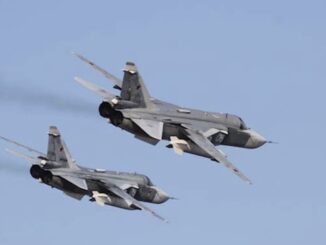
Russia is undertaking a trial run for a new, strategically vital oil and gas export route — one that will begin in the Baltic Sea and transverse icy Arctic waters before terminating in Asia.
Tankers with crude and oil products departed the Baltic ports of Primorsk and Ust-Luga last month and early this month to sail to China via the so-called Northern Sea Route (NSR). However, about two weeks ago two ships encountered thick ice in the Chuksi Sea and were forced to slow to a crawl, increasing sailing time and undermining the economics of the deliveries.
Oil shipments along the NSR are not new, but until now they usually started from Murmansk and other Arctic ports. By sending more cargoes from the Baltic Sea, Russia’s busiest maritime zone for hydrocarbon exports, Russia can cut time on water for vessels departing there for distant Asian ports.
To wit, an LNG cargo from Gazprom’s Portovaya facility on the Baltic Sea is now also plying the NSR in the first such sail.
The new route was proposed earlier this year by Rosatom, the state-owned nuclear corporation, after oil and products shipments from the Baltic to Europe ended due to sanctions. Rosatom, which operates a fleet of atomic icebreakers, said earlier this year that it was in talks with oil companies on redirecting export volumes to Arctic waters.
China-Bound
According to ship tracker Kpler, the Primorsky Prospect left Ust-Luga on Jul. 11 to deliver roughly 710,000 barrels of crude to the Chinese port of Dalian. Another tanker, NS Arctic, departed Primorsk on Jul. 23 to ship 730,000 barrels of crude to Rizhao in China.
Both were held up around Aug. 5, according to tracker data, and are now scheduled to arrive at port at the end of the month, indicating a seven-week journey.
Meanwhile, CF Irtysh departed on Aug. 5 also from Ust-Luga with 345,420 barrels of naphtha heading to the Chinese Zhu Hai, while Hammurabi left Primorsk on Aug. 8 to deliver 730,000 bbl of crude, also to China.
Nearly all the tankers are owned by Russian shipping giant Sovcomflot and have been chartered by Bellatrix, Demex Trading and Nord Axis. These firms have recently become regular offtakers of Russian oil export volumes now that international traders have left the scene due to sanctions. Hong Kong-based Nord Axis even acquired a 10% stake in Rosneft-led Vostok Oil Arctic venture from international commodity trader Trafigura last year.
Oil now en route to China via the NSR is believed to belong to Gazprom Neft and Rosneft. The former’s CEO, Alexander Duykov, said earlier this year the company was planning to test NSR shipments to China from the Baltic. Gazprom Neft’s crude, on three tankers from Murmansk, is also now plying the NSR.
Advantage vs. Risks
The main advantage of the Arctic route that it can slash delivery times by 30%-50%, depending on the point of departure, compared to crossing the Suez Canal. And crucially, since the NSR is fully controlled by Russia, transit risks are eliminated.
On the other hand, ice can ruin schedules. As the incident Primorsky Prospect and NS Arctic tankers showed, about six days were lost as they waited for an icebreaker to clear the path. And this occurred during the summer. In winter, conditions are harsher, so Moscow will have to arrange full-year navigation. For that Russia will have to boost its fleet of ice-class tankers and icebreakers.
In 2020, Gazprom Neft tested supplies of its Novy Port crude via the NSR. “As a result, we realized that such deliveries are generally possible, but they run into economic issues,” Vadim Simdyakin, then director of logistics, told Energy Intelligence in an interview.
No doubt, the economics didn’t work because Europe was still the key market for the company’s Arctic crude. However, Russian flows changed dramatically since February 2022 when the war in Ukraine closed traditional Western markets and forced oil companies to massively restructure flows. For instance, last October Lukoil sent 495,000 bbl of Varandei crude from Murmansk to Rizhao using a Sovcomflot tanker. The voyage took less than a month.
Gas Sails
Gazprom refused to comment on ship tracking data showing that the Velikiy Novgorod tanker took an LNG cargo from Portovaya on Aug. 11. The vessel is now sailing via the NSR to China’s Caofeidian and is expected there on Sep. 12, ship tracking data show.
Moscow sees LNG projects as a key driver for the planned growth in NSR transit volumes.
Novatek’s Yamal LNG has used the route for its exports since its launch in 2017. Yamal LNG now sends most LNG cargoes westward but hopes to send more east to Asia once there are enough icebreakers to support year-round navigation.
This year Yamal has so far sent 14 cargoes via NSR to Asia.
Novatek said in a recent report that although the eastern leg of NSR is the most complicated in terms of icy conditions, it reduces the delivery time to Asia-Pacific by half in summer and one-third in winter compared with shipments to Asia via Suez Canal. Such shipments also cut greenhouse gas emissions by an average 7,000 metric tons per round trip.



